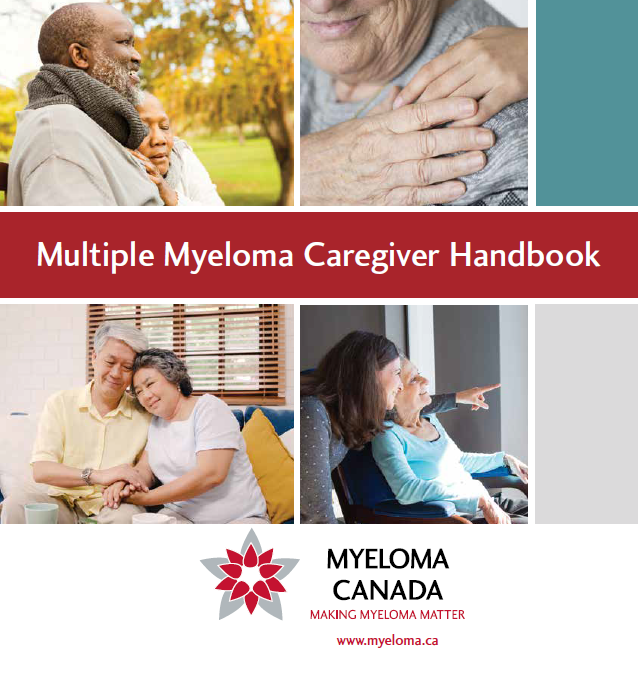
How to help after a loved one has been diagnosed with myeloma
Collecting information can help you and your loved one better understand, cope, and manage the condition. As early as possible following the diagnosis, it is helpful to start collecting and organizing key information such as:
You can also use electronic or online tools such as the Myeloma Monitor, an app designed specifically for people living with multiple myeloma and their caregivers. It is designed to help store and track information related to the disease, over time, in a centralized location. The secure (i.e. password-protected with all data encrypted) program can run on computers and mobile devices. All of the information entered is confidential and belongs to you—under no circumstances will your information be shared with anyone.

There are many different treatment options and possibilities for people living with myeloma, depending on the type of myeloma they have, the stageThe extent of a cancer in the body. of the disease, etc. Knowing the basics will help you ask questions and give you the background you need to help your loved one manage their appointments.
Before and during medical visits
To prepare for medical appointments, your loved one should record symptoms and jot down questions. If they’re unable to or forget to do so, you can prepare the list. If you’re present during visits, provide the healthcare team with this information at the beginning of the appointment. If there isn’t enough time to cover all of the items, request a follow-up visit or ask if another member of the team can help address them. You may also want to take notes or record important discussions.
Myeloma Canada has discussion and decision-making guides to help you and the person you care for prepare for appointments.

Keep in mind that patients have rights and responsibilities. As a caregiver, make sure that your loved one’s rights and responsibilities are respected when interacting with the healthcare team.
Helping with therapy
The importance of drug adherence
Drug therapy for myeloma can be complex, and some patients may find it difficult to follow and adhere to the prescribed regimen. Not surprisingly, poor adherence can lead to worse outcomes. In general, motivation to follow therapy increases if the patient knows what each drug is for. You can help by providing reminders as needed, especially at the start of a new drug regimen.
Keep in mind that it is important to report any and all side effects your loved one is experiencing to their healthcare provider, even if they feel it is minor or if they’re worried about the treatment being stopped.

The Myeloma Monitor app can help you and your loved one manage daily life with myeloma.
People living with myeloma usually take several different drugs with a daily schedule that may vary. Setting up a system can make life a lot easier for your loved one and ease your own mind. Consider a simple chart with required medications, dosing schedule, drug storage instructions, and information on when refills are due. It may be useful to pick up a pill box at the pharmacy to help organize tablets and capsules.
Some treatments may be injected or administered through a central line. If you are willing and able, the nurse can teach you how to clean the central line to reduce the risk of infection and discomfort. Alternatively, there may be private or government at-home services available to assist you with these types of tasks.

Future treatment options
Your loved one’s doctor may recommend a treatment plan; however, it’s the person living with the disease who makes the final decision. Understanding the risks, benefits, administration, and requirements of different therapies will help your loved one make informed decisions.
As a caregiver, you can also help by researching treatment options. After all, treatment isn’t just about medical results: the person’s circumstances, preferences, and quality of life also come into play. If needed, you can step in as a “second voice” to ensure your loved one is being heard.

Understanding clinicalInvolving direct observation of a patient. trials
In your research, you may come across information about clinical trials. Learn more about what that entails and search ongoing trials to see if there’s a potential fit for your loved one.

Side effects can range from minor to severe, and knowing what to watch for can help you see side effects if and when they occur.
Coping with “roid rage”
Steroids can bring on various changes in mood and have also been linked to aggression in certain people. Ask your loved one to give you a heads-up when they take their steroids. You may both discuss steroidA type of hormone. Steroids are often given to patients along with one or more anticancer drugs and appear to help to control the effects of the disease on the body. dosing schedules with their healthcare provider as there may be some solutions that can help your loved one better manage the negative effects.

For more information, download the Multiple Myeloma Caregiver Handbook
If you are supporting a loved one living with myeloma, you are a caregiver. Myeloma Canada designed this Handbook to provide you with practical information about caring for your loved one and maintaining your own well-being.


